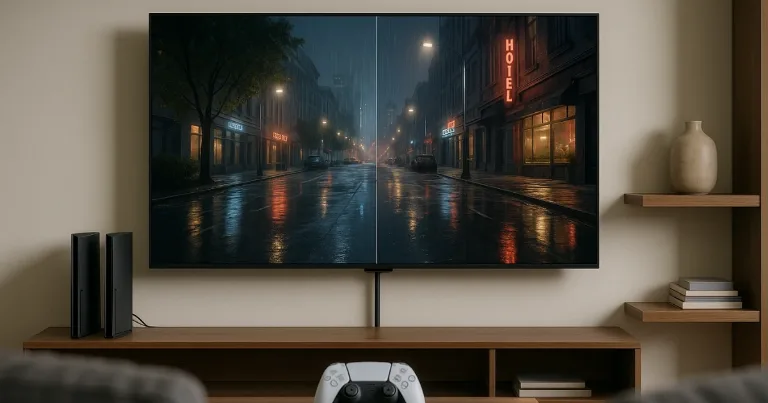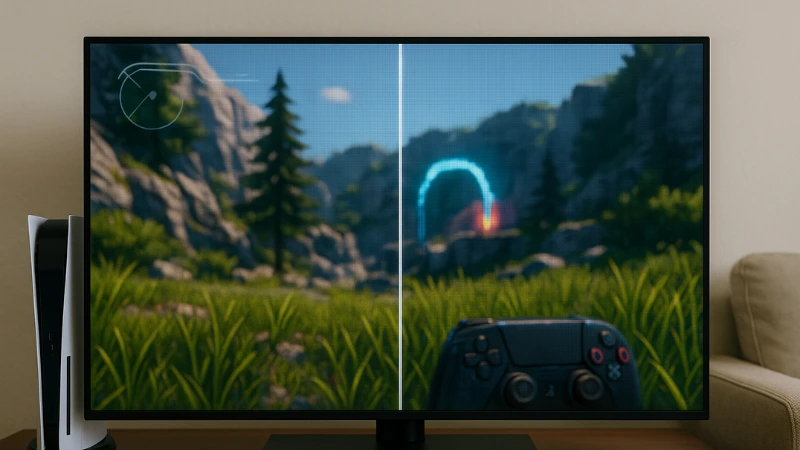PS5 vs PS5 Pro, real gains on a 4K TV

A 4K panel exposes strengths and limits fast. The Pro variant expands render budgets and steadies frame delivery, but the key is how that translates to actual 4K viewing from a couch distance. I profiled common genres, watched frame time behavior, and aligned TV settings with current standards.
What you actually see at 4K
On a calibrated 4K display, spatial detail retention is higher on the Pro. Fine geometry, sub pixel foliage, texture micro contrast, and thin UI strokes maintain structure during camera motion. Shader aliasing and distance shimmer are reduced. The base PS5 remains strong, yet the Pro preserves high frequency detail across more scenes and heavier effects.
Upscaling and sharpness, PS5 vs PS5 Pro

Most 4K presentation modes rely on reconstruction rather than native 2160p. PS5 Pro adds PlayStation Spectral Super Resolution, PSSR, a model driven upscaler that reconstructs from a lower internal resolution to a 2160p output. Compared with the base PS5’s common temporal reconstruction, PSSR holds edge acuity and surface detail better through motion and post effects, with fewer temporal artifacts and less stair stepping. Sony outlined PSSR and broader Pro targets in the official PlayStation 5 Pro announcement.
Different platforms render and transmit 4K output in different ways, from native 2160p to reconstructed frames and sharpening, so align expectations to the actual pipeline.
Frame rate stability, 60 and 120 fps
At 60 frames per second targets, Pro configurations display higher frame time consistency under heavy load. Where base PS5 profiles may oscillate between 16.7 and 25 milliseconds, Pro profiles hold closer to budget with fewer deep excursions. At 120 Hz, competitive modes often trade internal resolution for throughput. Pro hardware sustains higher minimums and improves input latency, especially when paired with a 120 Hz low latency preset. Forty frames per second at 120 Hz remains an excellent motion quality option because it yields even frame pacing at 25 milliseconds while preserving higher visual settings.
Ray tracing quality and effects
PS5 Pro enables elevated ray traced presets in supported titles. Reflection probes resolve more scene detail, shadow penumbra is cleaner with reduced noise, and denoiser stability improves during motion. Screen space fallbacks still exist, but the mix biases more toward ray traced data. The base PS5 typically trims ray count or reflection resolution to protect frame rate. On the Pro, higher ray budgets can coexist with a 60 frames per second target more often.
HDR brightness and tone mapping
Both consoles output robust HDR, but mapping is only as good as setup. Use the console HDR tool to align peak white so the third pattern just vanishes, then match the TV to HGIG or a no tone mapping mode if available. This keeps the electro optical transfer function accurate. The Pro does not increase display nit capability, yet cleaner frames preserve highlight detail through bloom, depth of field, and film grain, so speculars clip less in challenging scenes.
VRR and low frame dips on a 4K TV
Variable Refresh Rate masks minor deviations from target by syncing refresh to delivered frames. With Pro hardware operating nearer to 60 frames per second under stress, VRR eliminates most perceptible stutter and reduces judder and tearing. If your set exposes a VRR graph, you will observe fewer excursions toward the lower bound and quicker recovery to the nominal operating point.
Best 4K TV settings for each console
-
Select the TV Game or PC labeled input, disable motion interpolation and edge enhancement.
-
Enable the HDMI Enhanced or 4K 120 input mode, and use an Ultra High Speed HDMI cable.
-
On console, set 120 Hz enabled, VRR enabled, and Resolution on Automatic with ALLM active.
-
Run the three step HDR calibration. If the TV offers HGIG, prefer it over manufacturer tone mapping.
-
Keep TV sharpness near zero. Allow in game anti aliasing and reconstruction to govern detail.
-
Experiment with 1440p at 120 Hz for titles offering a 40 frames per second mode on Pro hardware.
Which game types gain the most
-
Large open worlds, improved foliage resolve, distant geometry stability, and reduced temporal crawl.
-
Effects heavy action, higher reflection quality, denser particles, and steadier composition under alpha load.
-
Racers and shooters at 120 Hz, better frame time floor and lower end to end latency.
-
Cinematic third person titles using quality modes, superior reconstruction fidelity with fewer artifacts.
Upgrade or skip, based on your TV and use case
Upgrade if you own a 4K 120 Hz display with VRR and care about sharper reconstruction, steadier frame pacing, higher ray tracing quality, and more resilient 120 Hz modes. Skip if you use a 60 Hz set or prioritize cost over incremental fidelity and stability. The base PS5 remains capable. The Pro is a refinement of image quality and frame delivery, not a generational reset.
About the author
Alex David Du
I’m Alex. I’m 28, born in Brazil, studied computer science, and writing is how I communicate best. I cover gaming, tech, simple ways to make money online, and other things I find interesting. I also love coding and building projects that bring ideas to life.
- Languages
- Portuguese, English
- Work Mode
- Freelancer - Remote
- Country
- Brazil
- hello@byalexdavid.com